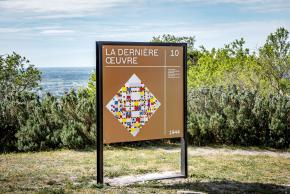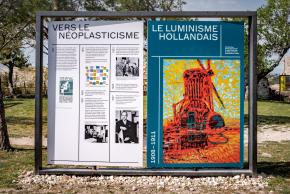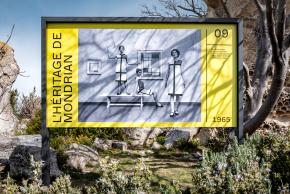Exhibition
Mondrian
La quête de l'abstraction
Throughout the yearIn complement to the programme of the Carrières des Lumières, the Castle of Les Baux-de-Provence is holding an outdoor exhibition that retraces the life and work of the Dutch artist Piet Mondrian (1872–1944). You are able to stroll around in the gardens of Les Baux-de-Provence and admire─in this unique setting─the emblematic works of this major twentieth-century artist.
Piet Mondrian, the Dutch painter and theorist, is famous for his fascinating abstract works composed of grids of horizontal and vertical lines, creating a series of quadrangular colour planes. In quest of a universal pictorial language adapted to the modern era, Mondrian played an important role in the development of abstract art. He is in particular known for being the founder of Neoplasticism, an artistic movement that promoted rigorous geometric abstraction, whose creative process was almost doctrinal. This aesthetic vision was rooted in the journal De Stijl (meaning ‘The Style’ in Dutch) and the group of the same name founded in 1917 by Mondrian and his compatriot Theo van Doesburg. Mondrian’s revolutionary and influential works contributed to making abstract art a major form of artistic expression in the twentieth century.
But while he remains famous for his abstract works, Mondrian nevertheless began his artistic career as a figurative artist. He pursued a lengthy aesthetic process of simplification and reduction before he achieved complete abstraction in his works. Influenced by nineteenth-century Dutch landscape painting, he began his career as a traditional Dutch landscape artist, and was subsequently influenced by Symbolism, Neo-Impressionism, Luminism, and cubism. It was in the years 1914-1915 that he developed his own pictorial language: shifting away from figuration, he produced radically geometric paintings and used pure primary colours. Throughout his quest to develop his own personal style, Mondrian produced many innovative works, not only in terms of the expressive and chromatic power that characterised them, but also the dynamism of the lines.
Via eleven large-format exhibition display panels combining photographs and reproductions, this exhibition covers the key phases of Mondrian’s career and the various aesthetic and philosophical influences that nourished it. The exhibition highlights the aesthetic thinking that formed the basis of his work throughout his career─from his early academic works to his most abstract works─, and which made him a leading figure in abstract art in the twentieth century.














